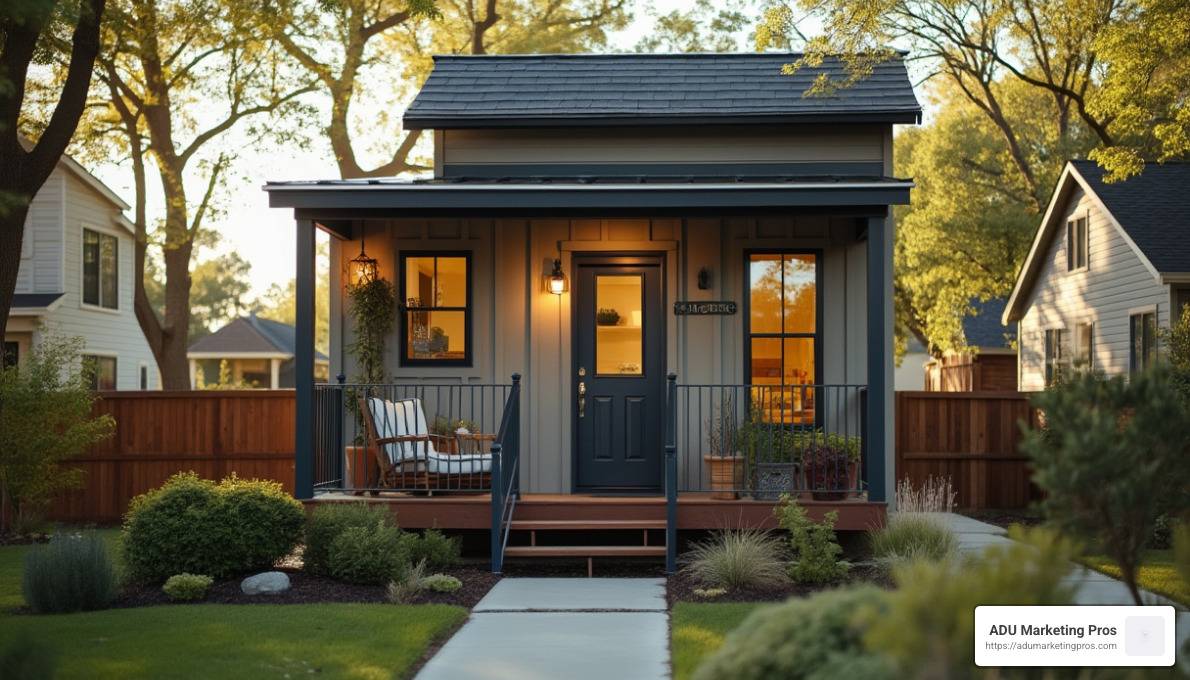Understanding Freddie Mac ADU Rental Income Policies
Freddie Mac ADU rental income refers to rental income from an accessory dwelling unit (ADU) that Freddie Mac allows borrowers to use when qualifying for a mortgage. To quickly understand how this works, here’s what you need to know:
- Eligible Properties: Only a 1-unit primary residence with one ADU is eligible (no multiple ADUs).
- Rental Income Limits: Income from the ADU can’t exceed 30% of the borrower’s total qualifying income.
- Documentation Needed: You must provide a lease agreement; Freddie Mac considers up to 75% of the lease amount.
- Appraisal Requirements: You’ll need a full appraisal with at least one comparable sale with an ADU.
- Landlord Education: If you’re using ADU rental income for a purchase, you must complete landlord education unless you have at least one year of landlord experience.
Freddie Mac’s guidelines can make ADUs a smart way for homeowners to offset their mortgage costs. According to Freddie Mac:
“ADUs can add value to a borrower’s home, provide additional space for extended family, or allow a borrower to earn rental income—all while addressing the nation’s affordable housing shortage.”
If you’re building or marketing ADUs, understanding these rules helps you educate your customers and adds value to your offering.

Key terms related to Freddie Mac ADU rental income:
What is an Accessory Dwelling Unit (ADU) According to Freddie Mac?
If you’re considering an ADU to boost your home’s potential or add extra income, understand exactly how Freddie Mac defines an accessory dwelling unit. Knowing what counts as an ADU is especially important if you’re planning to use Freddie Mac ADU rental income to qualify for your mortgage.
Freddie Mac describes an ADU as “a living area independent of the primary dwelling unit that has a separate entrance.” Sounds straightforward, right? Well, let’s break it down a bit more clearly to make sure there’s no confusion.
Independent Living Area
First, your ADU needs to function as its own independent space. Even though it can share walls and utilities with the main home, it must provide all the basics needed for independent living. Think of it as a cozy mini-home within your property—complete with all the essentials.
Separate Entrance Requirement
This is crucial. Your ADU must have its own separate entrance, meaning someone living there shouldn’t have to walk through your main home to access their living space. For example, a converted basement or garage that can only be entered through your main house wouldn’t qualify. But a basement with its own private, walk-out access and no open connections to the main house would meet Freddie Mac’s criteria.
Kitchen and Bathroom Requirements
Here’s a fun fact: Freddie Mac requires your ADU to have both a kitchen and a bathroom—but surprisingly, a bedroom isn’t mandatory! According to their guidelines, a kitchen is simply “a dedicated area where food is stored, prepared, and cooked.” Freddie Mac doesn’t specify exactly what kind of cooking appliances you must have, giving you some flexibility.
So yes, even if your ADU is a charming efficiency unit without a separate bedroom, Freddie Mac can still consider it a valid ADU—as long as it has that dedicated kitchen space and a bathroom.

Legal Compliance
Lastly, your ADU must legally comply with local zoning and land-use regulations. Freddie Mac generally wants your ADU to follow local laws, but there’s a helpful exception: if your ADU doesn’t fully meet local zoning rules, Freddie Mac might still allow it—as long as your appraiser can show at least two other comparable sales with similarly “non-compliant” ADUs, proving there’s a common market for it.
It’s also worth mentioning that Freddie Mac recently expanded eligibility to include properties with 1-, 2-, and 3-units. However, Freddie Mac ADU rental income can only be used to help qualify for a mortgage on a 1-unit primary residence—not multi-unit buildings. To dive deeper into Freddie Mac’s official guidelines, you can check out their detailed requirements here.
Understanding Freddie Mac’s ADU definition can make all the difference when you’re counting on rental income to qualify for your mortgage. The clearer you are on the guidelines, the smoother your financing journey will be!
Using ADU Rental Income to Qualify for a Freddie Mac Mortgage
If you’re considering building or buying a home with an ADU, one of the biggest perks is the ability to use Freddie Mac ADU rental income when qualifying for your mortgage. Freddie Mac recently updated their guidelines, making it easier than ever to leverage this rental income—and that’s great news for homeowners in expensive markets like San Jose and throughout the Bay Area.
Here’s what you need to know about using ADU rental income to boost your mortgage qualification:
Freddie Mac allows rental income from an ADU to qualify for mortgages, but only if the main property is a 1-unit primary residence. While Freddie Mac has expanded ADU eligibility to include 1-, 2-, and 3-unit properties, it’s important to know that rental income from ADUs on 2- or 3-unit properties can’t be used for mortgage qualification. So, if your plan is to offset costs with ADU rental income, stick to single-family properties that feature one ADU—no multiple ADUs allowed.
Another important consideration is your transaction type. Freddie Mac permits ADU rental income only for purchase and rate/term refinance loans. If you’re thinking about a cash-out refinance, unfortunately, ADU income can’t come to the rescue.
Let’s talk about zoning compliance—because that’s a biggie. Freddie Mac generally requires the ADU to comply with local zoning and land use regulations. However, there is a helpful exception: if your 1-unit property has a non-compliant ADU, Freddie Mac may still approve it if your appraiser can show at least two comparable sales featuring similar non-compliant ADUs. Essentially, they want to see proof that the market accepts and values this type of property.
One more quick note: if your ADU is a manufactured home, it needs to be either site-built or modular to qualify. However, if your primary residence itself is manufactured, Freddie Mac won’t accept that property for sale.

Documentation and Verification
Ready to include ADU rental income in your mortgage application? Great! Just remember: documentation is your best friend. Freddie Mac wants clear proof that your rental income is reliable, stable, and likely to continue.
First, you’ll need a copy of the signed lease agreement. For purchase transactions, provide the executed lease if you already have a tenant lined up—this demonstrates immediate income potential. For rate/term refinance transactions (where you’ve acquired the property in the current calendar year), Freddie Mac requires a copy of your current lease.
Next, you’ll need an appraisal report. This isn’t just any appraisal; Freddie Mac specifically requires that the appraisal includes at least one comparable sale featuring an ADU. The appraisal helps validate both the marketability of your property and the projected rental income.
Also, when calculating income, Freddie Mac won’t count 100% of the rent. Instead, they use 75% of the lease amount, factoring in potential vacancy periods or maintenance costs—pretty realistic, right?
One important limit to keep in mind: Freddie Mac restricts the ADU rental income to a maximum of 30% of your total qualifying income. This means ADU rental income can absolutely help boost your qualifying power, but it can’t become the dominant source of income in your application. Freddie Mac sums it up nicely:
“Rental income from an ADU can be used to qualify for a mortgage on a 1-unit primary residence, but it cannot exceed 30% of the total income used to qualify.” – Freddie Mac Guidelines
When you’re entering your income data into Freddie Mac’s Loan Product Advisor (LPA), make sure you select “Accessory Unit Income” as the Income Type. Otherwise, your application might get hung up with processing delays or errors.
Finally, keep in mind you’ll need to complete a landlord education course if you’re purchasing a property and don’t have at least one year of previous landlord experience. This course provides helpful tips on managing rental properties and must be provided by an independent education provider (someone with no interest or role in your loan transaction). Once completed, you’ll receive a certificate of completion to add to your documentation package.
By clearly packaging these documents and understanding Freddie Mac’s ADU rental income guidelines, you’ll present yourself as an informed borrower who’s done their homework. If you’re an ADU builder or marketer in the Bay Area, share these insights with your customers—it’ll help them see how investing in an ADU can directly support their financial goals.
Curious to learn more? Check out our detailed guide on ADU Rental Market Trends to see what’s happening right now in your local market, or explore how ADU Rental Income Taxes could impact your financial planning.
Appraisal Requirements When Using ADU Rental Income
If you’re planning to use Freddie Mac ADU rental income to help qualify for your mortgage, you’ll need to understand the special appraisal requirements involved. Unlike standard home loans, ADU rental income situations require more detailed documentation to ensure everything is properly valued.
Appraisal Report Necessity
Here’s something important to know right away: when you’re using ADU rental income, you can’t skip the appraisal process. Those convenient appraisal waivers (what Freddie Mac calls “ACE offers”) simply aren’t an option in these cases. You’ll need a full, detailed appraisal report—no exceptions.
Your appraiser will need to thoroughly document your ADU, including its square footage, room count, all amenities, overall condition, and most importantly, verify it has that required separate entrance. Think of this as creating a complete profile of your ADU that helps establish both its value and rental potential.
“We see many clients surprised by this requirement,” says our San Jose team lead. “They assume the automated valuation will work like with traditional homes, but with ADUs, Freddie Mac wants a professional’s eyes on the property.”

Comparable Sales Requirements
Your appraiser faces an interesting challenge with ADUs: finding similar properties to compare yours against. At minimum, they must include at least one comparable sale with an ADU. This requirement helps establish that ADU properties are marketable in your area and provides a basis for determining how much value the ADU adds to your overall property.
If your ADU doesn’t quite meet local zoning requirements (and your property is a 1-unit dwelling), there’s a special provision: the appraiser must find at least two comparable sales with similar non-compliant ADUs. This shows that even with zoning issues, there’s still a market for your property type.
We recently worked with a client in Oakland whose garage conversion ADU wasn’t fully permitted. Their appraiser was able to find three similar properties that had sold recently, which made all the difference in getting their loan approved.
ADU Rental Analysis
When it comes to analyzing potential rental income, your appraiser needs to do their homework. They’ll need to provide:
- A minimum of three comparable rental properties
- At least one of these must have a rented ADU
- Form 1000 (Single-Family Comparable Rent Schedule) or a detailed comparable rent schedule
This rental analysis isn’t just a formality—it’s the foundation for calculating how much income Freddie Mac will consider from your ADU. The appraiser’s estimate of market rent becomes the starting point (before they apply the 75% factor we mentioned earlier).
As one appraiser we work with in Palo Alto noted:
“When appraising properties with ADUs for Freddie Mac financing, I need to be especially thorough in documenting comparable ADU rentals. The Bay Area market has unique rental characteristics, and finding appropriate comparables with ADUs can be challenging but essential for an accurate valuation.”
Landlord Education and Experience Requirements
If you’re buying a property and planning to use Freddie Mac ADU rental income to qualify, there’s one more requirement to know about: landlord education. At least one borrower must complete a landlord education course before the loan closes. This makes sense when you think about it—Freddie Mac wants to ensure you understand what you’re getting into as a landlord.
Good news if you’ve done this before: if at least one borrower has a minimum of one year of previous landlord experience, you can skip the education requirement completely.
If you do need to take the course, keep these points in mind:
- The course can’t be provided by anyone with a financial interest in your transaction
- You’ll need to provide proof that you completed the course
- The format is flexible—classroom, online, or other formats are all acceptable
This education requirement reflects Freddie Mac’s commitment to responsible lending. They want to make sure you’re prepared for the realities of being a landlord, which ultimately protects both you and their investment.
For our clients throughout California, we often recommend completing this education requirement early in the process. It’s one less thing to worry about as you approach closing, and the knowledge truly does help you better understand the commitment you’re making with your ADU rental property.
Limitations and Considerations in Using ADU Rental Income
While Freddie Mac ADU rental income can be a fantastic resource for homeowners, it’s important to go in with your eyes wide open. There are some important limitations and considerations you’ll need to keep in mind to avoid surprises during your mortgage application process.
Income Limitation (30% Rule)
One of the key rules to know is that your ADU rental income can’t exceed 30% of the total monthly income Freddie Mac uses to qualify you for the mortgage. Basically, Freddie Mac is making sure you aren’t relying too heavily on rental income from your ADU to afford your monthly payments.
Here’s how it works: Let’s say your total monthly qualifying income (from employment, investments, etc.) is $8,000. To figure out the maximum rent from your ADU that you can count, you’d calculate it like this: $8,000 ÷ 0.7 × 0.3, which equals about $3,428.
Freddie Mac’s system (Loan Product Advisor or LPA) is smart enough to catch this. If the ADU rental income you enter goes above that 30% limit, you’ll get a warning and risk a purchase restriction. So, understand this rule early in the process.
Income Calculation (75% Rule)
Another important consideration is how Freddie Mac calculates your rental income. They will only count 75% of your gross rental income toward qualification. This might seem a little unfair at first glance, but it’s to account for times when your ADU might be vacant or require maintenance.
So, if your ADU rents for $2,000 per month, Freddie Mac will only count $1,500 toward your qualifying income. It’s a built-in safety cushion, reducing risk for you and Freddie Mac.
Zoning and Compliance Issues
Compliance with local zoning laws is crucial. Under Freddie Mac guidelines, your ADU must typically be legally compliant or considered legally non-conforming with your local jurisdiction. If your ADU is considered illegal, Freddie Mac won’t let you use the rental income from it at all.
There’s an interesting wrinkle, though: If your ADU isn’t fully compliant (but not technically illegal) and it’s a 1-unit property, Freddie Mac might still let you use the rental income—but only if the appraiser can show two comparable sales with similar non-compliant ADUs. The appraiser will have to clearly demonstrate that these non-compliant units don’t negatively affect marketability, safety, or structural integrity.
If you’re not sure about your property’s compliance status, it’s a smart idea to check your local zoning regulations early. You can also review Freddie Mac’s detailed zoning requirements here.
Managing Potential Challenges
Let’s face it—navigating Freddie Mac ADU rental income guidelines can throw some curveballs your way. Knowing about potential issues upfront will help you stay prepared and stress-free.
Documentation can sometimes be tricky, especially during a purchase transaction when a lease might not yet be in place. In these scenarios, your appraiser’s Form 1007 (Single-Family Comparable Rent Schedule) becomes even more critical to proving the potential rental income. If you’re an ADU Marketing Pros client in Mountain View or Sunnyvale, we highly recommend preparing a clear documentation checklist to smooth the path through these complexities.
Another common challenge is the appraisal process itself. Since Freddie Mac requires at least one comparable sale with an ADU (or two comparables if your ADU is non-compliant), your appraiser might struggle if ADUs are rare in your area. Working with an appraiser who has specific experience with ADUs will greatly reduce this headache and help ensure accuracy.
Lastly, don’t overlook the landlord education requirement for purchase transactions. Many borrowers are caught off guard by this. Unless you already have at least one year of landlord experience, Freddie Mac requires you to complete a landlord education course before your mortgage closes. It’s easy to procrastinate, but we strongly suggest getting this completed early to avoid last-minute hiccups.
One mortgage advisor we spoke with shared this insight:
“The landlord education requirement often catches borrowers by surprise. I always advise clients planning to use ADU rental income to complete the course as soon as possible to avoid last-minute complications.”
By wrapping your head around these limitations and proactively addressing potential challenges, you’ll set yourself up for a smoother mortgage qualification experience. With the right preparation—and maybe a little help from ADU Marketing Pros—you’ll be well-equipped to steer the ins and outs of Freddie Mac ADU rental income.
For additional insights, you might want to explore ADU Rental Market Trends to get a better handle on the local rental landscape.
Benefits of Including ADU Rental Income in Your Mortgage Application
Leveraging Freddie Mac ADU rental income isn’t just about qualifying for a bigger mortgage—though that’s certainly a great perk! It also has a number of other meaningful benefits for homeowners, especially in high-cost areas like San Jose, Los Angeles, and San Diego, where housing affordability can feel like a distant dream.
Offsetting Mortgage Payments
Probably the most immediate (and satisfying!) benefit is using your ADU rental income to help offset your monthly mortgage payment. Think about it: say your monthly mortgage is around $4,000, but you have an ADU generating $2,000 per month. Just like that, you’ve effectively cut your housing expense in half.
Even after accounting for expenses like maintenance, taxes, and insurance, this extra income can make the difference between feeling financially stretched or comfortably breathing easy each month.
Increased Qualifying Income
Here’s another big one—your ADU rental income directly boosts your qualifying income. Freddie Mac allows you to include this additional income when you apply for a mortgage, up to 30% of your total qualifying income. By doing so, you can potentially finance a larger loan or enjoy better terms.
Let’s break that down with a quick example. Suppose your regular monthly income from your job is $10,000. You could potentially add up to around $4,285 in qualifying ADU rental income (calculated as $10,000 ÷ 0.7 × 0.3). That extra income might just be the difference between settling for a smaller place and landing your dream home.
Supporting Affordable Housing
There’s also a feel-good aspect in all this: owning a home with an ADU helps address the affordable housing shortage. ADUs typically rent for much less than traditional homes or apartments, making them attractive options for renters in high-cost communities.
Freddie Mac itself recognizes this important benefit, noting that ADUs are usually valued at less than one-third of the cost of traditional housing. So, by choosing to finance a home with an ADU, you’re not only boosting your own financial position but doing good for your community, too. Nice job, superhero homeowner!

Multigenerational Living Options
One of the most loved aspects of ADUs is the flexibility they provide. You might initially use your ADU to generate Freddie Mac ADU rental income and help qualify for your mortgage. But later on, it could become a comfortable living space for your aging parents, adult kids, visiting relatives—whoever might need a cozy spot to call home.
And that’s especially appealing in diverse communities throughout California, where multigenerational living arrangements are common and highly valued.
Property Value Improvement
Another fantastic advantage is the way ADUs can boost your overall property value. Freddie Mac research shows that properties with ADUs tend to enjoy higher market values over time. In fact, a recent study found that historically, homes with ADUs can sell for around 35% more than comparable properties without ADUs, and as of 2025, that trend shows no signs of slowing.
Case Study: Bay Area Homeowner Leverages ADU Income
Let’s look at a real-life example from one of our ADU Marketing Pros clients in Palo Alto. They recently purchased a home with an existing ADU. Using the projected rental income in their mortgage application allowed them to qualify comfortably for a home that otherwise might have been out of reach due to the high Bay Area prices.
The ADU rents out for $2,400 per month, and Freddie Mac allows them to count 75% of that—$1,800—as qualifying income. Not only did this help them qualify for the mortgage, but it also significantly reduces their monthly mortgage burden. As the homeowner happily shared with us:
“Understanding Freddie Mac’s guidelines for ADU rental income was a game-changer for us. Without being able to include that income, we simply couldn’t have afforded this home. Now the ADU not only helped us qualify, but it’s also covering nearly a third of our monthly mortgage payment.”

At ADU Marketing Pros, we understand how impactful leveraging Freddie Mac ADU rental income can be for homeowners. Whether you’re an ADU builder, architect, or homeowner, clearly communicating these benefits can help your clients make informed decisions—and confidently move forward with their investments.
For more insights into financing your ADU project, check out our helpful resource on ADU Financing Options.
Frequently Asked Questions about Freddie Mac and ADU Rental Income
At ADU Marketing Pros, we work closely with California’s ADU construction and architecture firms, and naturally, we’ve received a lot of questions about Freddie Mac ADU rental income. To make things easier for you, we’ve answered some of the most common questions below—warmly, simply, and with a dash of humor where appropriate (because mortgage rules don’t always have to feel like reading a textbook!).
Can I use ADU rental income from a 2- or 3-unit property for mortgage qualification?
Unfortunately, that’s a no-go. While Freddie Mac does allow ADUs on 1-, 2-, and even 3-unit properties, you can only use rental income from an ADU to qualify for a mortgage when the property is a 1-unit primary residence.
As Freddie Mac clearly states:
“At this time, rental income is only allowed on an ADU for a 1-unit primary residence.”
So, if you’re marketing ADUs in multi-unit properties, make sure your clients understand this important distinction. They can still earn rental income from the ADU, but they won’t be able to use that income to boost their mortgage qualification.
What documentation is needed to use ADU rental income?
Gathering the right paperwork is key to successfully using Freddie Mac ADU rental income for mortgage qualification. Here’s what you’ll typically need:
First, you’ll need a lease agreement. For purchase transactions, provide a copy of the executed lease if available. For refinances (if the property was bought in the current calendar year), a current lease agreement is required.
You’ll also need a detailed appraisal report—no shortcuts here. Freddie Mac doesn’t accept appraisal waivers (ACE). The report must clearly describe the ADU, including amenities, size, and condition. Additionally, the appraisal must show at least one comparable sale with an ADU and include a rental analysis with at least three comparable rentals (one of which must have an ADU).
A completed Form 1007 (Single-Family Comparable Rent Schedule) or similar detailed comparable rent schedule must also be included to support the monthly market rent estimate for the ADU.
Lastly, Freddie Mac has a landlord education requirement for borrowers using ADU rental income on a purchase transaction. You’ll need a landlord education certificate unless you have at least one year of landlord experience. If you’re skipping the class, you’ll need proof of landlord experience, such as previous lease agreements, tax returns showing rental income, or property management records.
We recommend our ADU Marketing Pros clients create easy-to-follow documentation checklists for prospective homeowners, so they’re prepared and informed from the start.
Is landlord education mandatory when using ADU rental income?
In most cases, yes. For purchase transactions using Freddie Mac ADU rental income to qualify, at least one borrower must complete a landlord education course. But don’t panic yet—there’s a helpful exception: If you have at least one year of prior landlord experience, you can skip the class (lucky you!).
If you’re required to take the course, make sure it’s provided by an independent organization—not the lender, real estate agent, or any other interested party. Courses can be online or in-person, as long as you get your shiny certificate of completion and submit it with your mortgage application.
One mortgage advisor we work with cheerfully advises:
“Don’t underestimate the value of landlord education! It might feel like a chore, but it’ll actually save you potential headaches down the road. Plus, you’ll finally understand why your landlord seems so stressed out sometimes.”
Can I use ADU rental income if I’m planning to build the ADU after purchase?
This one’s pretty straightforward: Nope! Freddie Mac requires the ADU to be already built and ready to rent at the time of your mortgage application to use the rental income for qualifying purposes.
But hold your horses—there’s still good news! If you’re thinking about adding an ADU after you buy, Freddie Mac offers the CHOICERenovation® mortgage program to finance ADU construction. While future rental income can’t help you qualify initially, it’s a great way to boost your property’s value and offset future housing costs.
If I live in the ADU, can I use rental income from the main dwelling for qualification?
Again, sadly, Freddie Mac says no. If you’re cozying up in your ADU and renting out the main house, Freddie Mac won’t allow that rental income to help you qualify. They specifically restrict this scenario to ensure the main property remains owner-occupied as the primary residence.
A little quirky, perhaps—but rules are rules!
How does Freddie Mac verify ADU rental income?
Freddie Mac uses a straightforward but thorough verification process for your Freddie Mac ADU rental income:
They’ll start by looking at the lease agreement to confirm actual rental figures. They’ll also carefully review the appraisal rental analysis, which must include three comparable rentals (with at least one having a rented ADU).
Next, Freddie Mac applies what’s called the “75% rule,” reducing the gross rental amount to allow for vacancies and expenses. So, if your ADU rents for $2,000 per month, only $1,500 counts towards your qualifying income.
Finally, they’ll check that your ADU rental income doesn’t exceed their “30% rule“—meaning your ADU rental income can’t be more than 30% of the total monthly income used to qualify. Freddie Mac’s Loan Product Advisor automatically verifies this limit, making sure borrowers aren’t overly reliant on ADU rental income.
By clearly understanding this verification process, ADU builders and marketers can set realistic expectations with their customers—making the entire home-buying journey smoother and stress-free.

Conclusion
Understanding Freddie Mac ADU rental income guidelines is essential if you’re considering an Accessory Dwelling Unit to support your mortgage qualification. This guide has covered the key requirements and advantages, helping you make informed decisions about leveraging your ADU investment.
One crucial takeaway is that Freddie Mac allows rental income from an ADU only on a 1-unit primary residence, and exclusively for purchase or rate/term refinance transactions. So, if you’re considering multi-unit properties, keep in mind that ADU rental income can’t be used for qualification in those scenarios—stick to single-unit homes to take advantage of this benefit.
Additionally, Freddie Mac does have some restrictions on income calculation. They will count only 75% of your ADU’s actual lease amount as qualifying income to account for vacancies and maintenance. Plus, your ADU rental income cannot exceed 30% of your total qualifying income. While these limits may seem strict at first, they protect borrowers by ensuring they aren’t overly reliant on rental income.
Proper documentation is another critical factor. Ensure you have clear, accurate records, including your lease agreement (if already in place), a thorough appraisal report with comparable ADU sales and rental data, and your landlord education certificate if you don’t have at least one year of prior landlord experience. Getting your ducks in a row early makes the mortgage approval process smoother—and who doesn’t appreciate fewer headaches during loan qualification?
Compliance with local zoning and land-use rules also matters significantly. While Freddie Mac sometimes allows exceptions for non-compliant ADUs on single-unit properties (with appropriate comparable sales), illegal ADUs are never eligible. Working closely with a knowledgeable appraiser and checking your local zoning regulations helps avoid potential hiccups and ensures you’re on the safe side of Freddie Mac’s guidelines.
Despite these guidelines and restrictions, the benefits of including Freddie Mac ADU rental income in your mortgage application can be substantial. Most notably, ADU rental income can significantly improve your mortgage affordability, helping offset monthly housing expenses and even enabling you to qualify for larger or more desirable homes. Plus, ADUs offer incredible flexibility—today, they can generate income, and tomorrow they can house aging parents or adult children, making them a smart, versatile investment.
At ADU Marketing Pros, we know how important it is for California homeowners and ADU construction professionals to stay informed about financing options, especially with evolving guidelines from Freddie Mac. Whether you’re in San Jose, Los Angeles, or anywhere across California, clearly understanding these rules helps you (or your clients) maximize your ADU investment.
We specialize in marketing ADU construction and architecture firms by highlighting the financial advantages ADUs can offer. Our targeted marketing strategies showcase how ADU rental income can improve mortgage qualification, support affordable housing, and improve property value—helping you stand out from competitors who focus solely on pricing.
Ready to learn more or need help navigating Freddie Mac’s ADU rental income guidelines? Contact ADU Marketing Pros today—we’re here to help you harness the full potential of your ADU investment.




